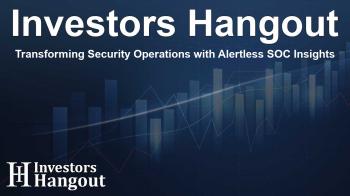Transforming Security Operations with Alertless SOC Insights

Understanding the Challenges of Alert-Centric SOCs
In the evolving landscape of cybersecurity, organizations are noticing significant inefficiencies in their Security Operations Centers (SOCs). A new report reveals that the traditional alert-centric SOC model could be contributing to these challenges, especially due to the overwhelming volume of alerts that analysts must manage. This situation causes analysts to repeat investigations unnecessarily, wasting valuable resources.
The Survey Insights on SOC Analyst Workloads
A recent survey, highlighting the need for a shift towards an Alertless SOC, indicates that a substantial percentage of SOC analysts experience frustration and burnout due to ineffective systems. The data shows that 83% of analysts feel swamped by alert overload, leading to errors and missed threats. Furthermore, nearly 85% of analysts invest considerable effort in gathering and verifying evidence to turn alerts into actionable security operations.
Repeated Investigations Waste Resources
It's alarming to find that 84% of organizations’ SOC analysts unknowingly inspect the same incidents multiple times a month. This redundancy is not just a minor annoyance; it can undermine the overall efficacy of an organization's security posture. Regular duplication in investigations, with reports stating that 60% of analysts encounter such overlaps at least once a week, highlights a systemic issue that needs addressing.
Overcoming the Reactive SOC Approach
Data also reveals that a majority of analysts tend to operate reactively, responding mainly to alerts rather than proactively hunting for threats. Nearly half of the survey participants indicated their primary discovery of security incidents comes from alerts, while only one-third reported finding threats through proactive measures. This reactive stance often leads to an underwhelming response to security challenges.
Barriers to Effective Security Operations
Issues stemming from inadequate SOC technology further complicate the situation. Analysts highlighted case management, threat intelligence integration, reporting metrics, and alert prioritization as significant shortcomings in their tools. These gaps hinder their ability to respond efficiently and effectively to potential security threats.
The Role of AI in SOC Enhancement
Amid these challenges, there is a clear opportunity for organizations to leverage artificial intelligence (AI) within their SOC frameworks. While some organizations have adopted AI for basic functions like alert severity monitoring and anomaly detection, there is a strong desire to use AI for proactive measures, such as automated alert triage and enrichment. A significant 82% of these organizations recognize the need to focus on proactive investigations, aiming for more sophisticated and streamlined processes.
Future Directions for Proactive Security
Looking ahead, companies show a strong inclination towards enhancing their security operations. A notable 81% expressed the desire to improve alert correlation and enrichment capabilities, while 80% are seeking ways to analyze more extensive data sources efficiently. These aspirations indicate a shift toward a more sophisticated, data-driven approach in managing cybersecurity.
Vision for the Alertless SOC
The concept of the Alertless SOC represents a transformative shift in how organizations approach security. By rethinking traditional methodologies, Devo Technology proposes an innovative framework that prioritizes intelligent automation and coordinated investigations. This vision champions a move away from reactive incident management, fostering a culture of anticipation and proactive threat hunting.
Emphasizing Intelligent Automation
In this new paradigm, organizations are encouraged to utilize intelligent automation not just as an enhancement, but as a fundamental principle guiding security operations. This reimagining of SOC operations can free up analysts to focus on critical thinking and strategic initiatives, vital for staying ahead of emerging threats.
Frequently Asked Questions
What are the main findings of the SOC survey?
The survey highlights significant pain points in traditional SOC operations, including high alert volumes and duplicated investigations, leading to inefficiency.
How does an Alertless SOC improve security?
An Alertless SOC aims to reduce the dependency on alerts by promoting proactive threat hunting and smart automation, enhancing overall operational efficiency.
What percentage of analysts deal with alert overload?
According to the survey, 83% of analysts report feeling overwhelmed by excessive alert volumes and related pressures.
What role does AI play in enhancing SOC functions?
AI can significantly improve SOC capabilities by automating alert triage and enriching threat intelligence, facilitating more proactive security measures.
What are organizations hoping to achieve with AI in their SOCs?
Organizations are eager to use AI to advance their security measures, focusing on proactive investigations, improving alert correlation, and making informed decisions on larger data sets.
About The Author
Contact Owen Jenkins privately here. Or send an email with ATTN: Owen Jenkins as the subject to contact@investorshangout.com.
About Investors Hangout
Investors Hangout is a leading online stock forum for financial discussion and learning, offering a wide range of free tools and resources. It draws in traders of all levels, who exchange market knowledge, investigate trading tactics, and keep an eye on industry developments in real time. Featuring financial articles, stock message boards, quotes, charts, company profiles, and live news updates. Through cooperative learning and a wealth of informational resources, it helps users from novices creating their first portfolios to experts honing their techniques. Join Investors Hangout today: https://investorshangout.com/
The content of this article is based on factual, publicly available information and does not represent legal, financial, or investment advice. Investors Hangout does not offer financial advice, and the author is not a licensed financial advisor. Consult a qualified advisor before making any financial or investment decisions based on this article. This article should not be considered advice to purchase, sell, or hold any securities or other investments. If any of the material provided here is inaccurate, please contact us for corrections.

